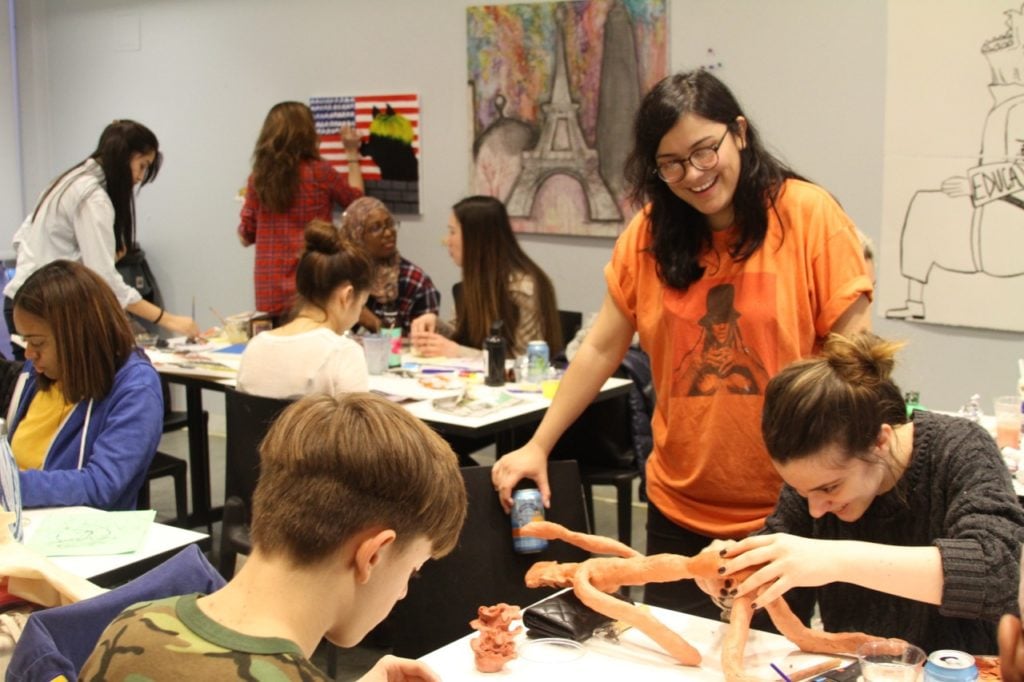Art World
School’s Out Forever: Bruce High Quality Foundation University Calls it Quits, Ending an Experiment in Free Art Education
Director Seth Cameron says the school was to some degree a victim of its own success.

Director Seth Cameron says the school was to some degree a victim of its own success.

Brian Boucher

After eight years of offering an alternative to formal education for young artists, New York’s Bruce High Quality Foundation University (often known by its acronym, BHQFU) is winding down its operation. Launched in Tribeca on September 11, 2009, by a semi-anonymous group of artists who work under the name Bruce High Quality Foundation, the school offered free classes to all comers, not only in order to increase accessibility to what it called an “MFA-quality” education but also as a critique of the burgeoning costs of higher education, which often leave students laboring under tens of thousand dollars of debt.
“We needed to open up a conversation about the best way to radically rethink the school,” BHQFU president Seth Cameron said in a phone interview. “Since we’d done it for eight years, we figured maybe it was time to drop a bomb” and shut down the operation. Cameron announced the program’s closure in a slightly inscrutable article in the Brooklyn Rail that employed a broken toilet at the school’s headquarters—and the resulting pileup of human waste—as an extended metaphor to explain the group’s decision.

House of Ladosha’s exhibition “This is UR Brain” appeared at the art school’s gallery in January 2016.
“We were fairly successful without growing a huge bureaucracy around fundraising,” said Cameron. “We organized one or two benefits a year, and with those we were able to consistently raise $300,000 to fund operations for the year. But we started to realize that if we were going to maintain that level, it was going to require more effort just to keep the thing afloat, which would take us away from being able to focus on projects. None of us is a fundraiser. We like to think about making a class happen.”
In addition to those traditional benefit events, which relied on donations from artists, the school was also partly funded by sales of works by BHQF itself. In a telling indication of the way the school effectively rode a thin line between the institutional and the anti-institutional, BHQF—whose changing members are casually referred to as “the Bruces”—was for a time represented by no less a bold-face name than the dealer Vito Schnabel. The collective sprang to life in minds of a group of students at the (formerly tuition-free) Cooper Union art school, and took its name from a fictional artist, Bruce High Quality, who was said to have died in the 9/11 attacks.
Over its eight-year run, BHQFU offered classes and critique sessions led by prominent artists and writers like Brian Droitcour, Juliana Huxtable, Elizabeth Jaeger, Rashid Johnson, Dana Schutz, and Brad Troemel. Some younger artists cite the classes as important influences, with Troemel’s anarchic class being a particular favorite.
Through the Bruces’ fun-filled non-juried exhibitions like the “Brucennial,” which always coincided with the Whitney Biennial (where the collective was featured in 2010) or other marquee shows, and through the school’s bold attempt to rethink the traditional structures of art education, BHQFU engendered enough goodwill that even such prominent figures happily lectured for as little as $50.
As a testament to the school’s recognition in institutional circles, artist-critic David Salle’s class in art writing was the subject of a two-part article in Art in America by P.C. Smith; coincidentally, the school’s demise coincides with an article about the school by Erica Dawn Lyle in the current issue (which gave no indication of the looming expiration date). The school also participated in a 2015 session on alternative art schools at the College Art Association’s annual conference, and, in 2011, the New York public art organization Creative Time sponsored a cross-country road trip for the group, dubbed “Teach 4 Amerika,” during which it mounted rallies and organized events at art schools.
But the bureaucratic demands of administering a program that enrolled as many as 800 students at a time finally caught up with the group, according to Cameron. “We were to some degree victims of our own success,” he said.
The school’s legacy, said one instructor who spoke off the record, will be a sense of optimism and possibility; a thriving network of young New York artist-alums; and proof of concept that an art education can be made available for less than $30,000 per student, per semester.
Cameron, for his part, says that the school’s main accomplishment is that it helped artists learn from each other. As for its legacy, he said, “In the school’s last iteration, a studio-plus-teaching residency, I think we hit upon a curricular model that could supplant the MFA entirely if it were implemented on a large enough scale. Then again, maybe it won’t happen, art schools will become fully obsolete on their own, and mere anarchy will be loosed upon the world.”